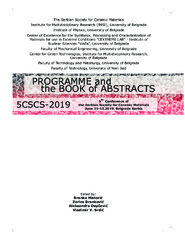| dc.description.abstract | Zinc oxide (ZnO) is a versatile functional material, widely employed in industry
and technology as varistor ceramics, transparent conducting films, surface acoustic
wave resonators etc. ZnO-based conductive ceramics, attractive for various
applications, should have low electrical resistivity and good linearity. The n-type
conductivity of wide band gap (3.37 eV) ZnO semiconductor could be enhanced by
multiple doping with trivalent metals (B3+, Al3+, Ga3+, In3+), as shallow donors. The
intrinsic defects, zinc vacancies and interstitial oxygen, exist in the grain boundaries
of n-type ZnO ceramics as localized acceptor states. These states attract charge
carriers, creating a depletion region around the grain boundaries and energy
potential barrier, which hinder the motion of the electrons [1]. In this work, zinc
oxide ceramics doped with Al3+, B3+ and Mg2+ was prepared using solid-state
reaction technique from ZnO powder obtained in solvothermal synthesis and Al2O3,
MgO and B2O3 (H3BO3) commercial powders. Al2O3 was used as a donor dopant to
increase the carrier concentration, B2O3 was added to enhance densification and
grain growth, and MgO – to decrease the thermal conductivity [2,3]. The pressed
ZnO (0.25 % Al2O3, 0.5 % B2O3, 1 % MgO) pellets were sintered by conventional
(CS) and spark plasma (SPS) method. The ceramic samples were analyzed by X-ray
diffraction (XRD), scanning electron microscopy (SEM), transmission electron
microscopy (TEM), UV-Vis spectroscopy and current-voltage (I–U) measurements.
The correlation between the sintering processing, microstructure and electrical
properties of multiple doped ZnO-based ceramics was investigated. The electrical
performances of ZnO (0.25 % Al2O3, 0.5 % B2O3, 1 % MgO) ceramics were
strongly dependent on composition and microstructure (density, grain size,
segregation of secondary phase in grain boundaries). The electrical resistivity of SPS
sample was an order of magnitude lower than electrical resistivity of CS sample and
it showed almost linear I-U characteristics in temperature range of (25–150) C.
1. T.K. Gupta, W.G. Carlson, J. Mater. Sci., 20 (1985) 3487
2. T. Tian, L. Cheng, J. Xing, L. Zheng, Z. Man, D. Hu, S. Bernik, J. Zeng, J. Yang, Y.
Liu, G. Li, Mater. Design, 132 (2017) 479
3. B. Yuksel, T. O. Ozkan, Mater. Sci. – Poland, 33 (2015) 220 | sr |

